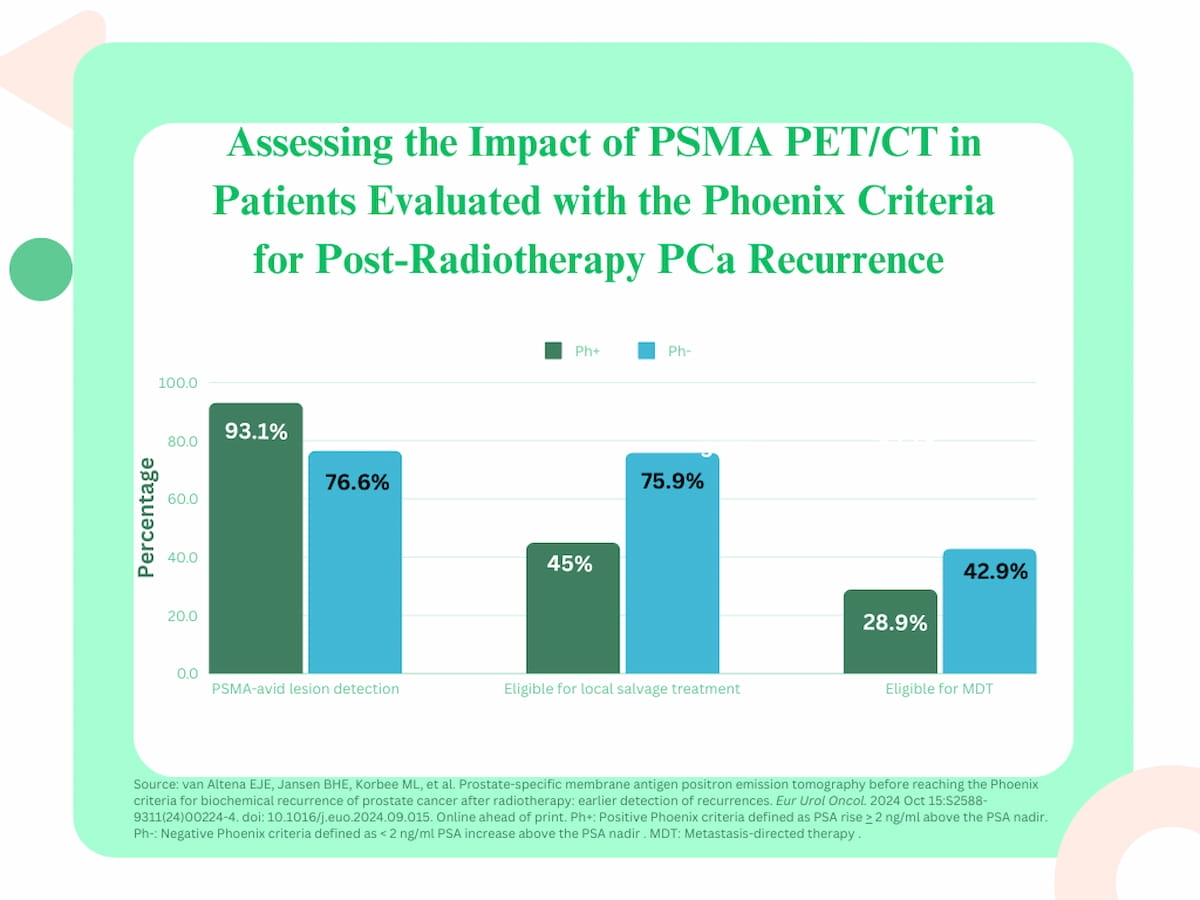New research revealed the detection of prostate-specific membrane antigen (PSMA)-avid lesions in over 75 percent of men with < 2 ng/ml prostate-specific antigen (PSA) level increases above nadir after radiotherapy treatment for prostate cancer (PCa)
For the retrospective study, recently published in European Urology Oncology, researchers reviewed follow-up data from 568 patients who had curative intent radiotherapy for PCa. The study authors noted that 346 patients in the cohort had positive Phoenix criteria (Ph+) for biochemical PCa recurrence, defined as PSA rise > 2 ng/ml above the PSA nadir, and 222 patients had < 2 ng/ml PSA increase above the PSA nadir (Ph-).
The researchers detected PSMA-avid lesions in 76.6 percent of Ph- patients and 93.1 percent of Ph+ patients. However, over 30 percent more of the Ph- patients with PSMA-avid lesions were eligible for local salvage treatment in contrast to those in the Ph+ cohort (75.9 percent vs. 45 percent), according to the study authors. Among patients with PSMA-avid lesions, the researchers found that eligibility for metastasis-directed therapy (MDT) was 14 percent higher in the Ph- cohort in comparison to the Ph+ group (42.9 percent vs. 28.9 percent).
“Early PSMA PET/CT imaging detected PCa recurrence at a less advanced disease stage that may be eligible for salvage treatment or metastasis-directed therapy,” wrote lead study author Evelien J.E. van Altena, M.D., who is affiliated with the Department of Urology at Amsterdam University Medical Centers in Amsterdam, the Netherlands, and colleagues.
(Editor’s note: For additional content on prostate cancer imaging, click here.)
Five-year follow-up data revealed that 33 percent of patients in the Ph- group required re-initiation of androgen deprivation therapy (ADT) in contrast to 67.6 percent in the Ph+ group. The researchers also noted that more than twice as many Ph+ patients progressed to castration-resistant prostate cancer (CRPC) in comparison to those in the Ph- group (27.9 percent vs. 13.6 percent).
Three Key Takeaways
1. Higher detection of recurrence using early PSMA PET/CT imaging. The study revealed that PSMA-avid lesions were detected in over 75 percent of patients with < 2 ng/ml PSA increase above the nadir after radiotherapy for prostate cancer (PCa), demonstrating that early PSMA PET/CT imaging can detect PCa recurrence at a less advanced stage.
2. Better salvage treatment eligibility in lower PSA increases. Patients with a PSA rise of < 2 ng/ml (Ph- group) showed higher eligibility for local salvage treatment compared to those with PSA increases > 2 ng/ml (Ph+ group) after detecting PSMA-avid lesions (75.9 percent vs. 45 percent).
3. Improved outcomes in Ph- patients. Patients in the Ph- group experienced a delay in the need for androgen deprivation therapy (ADT) and progression to castration-resistant prostate cancer (CRPC), along with longer overall survival, compared to the Ph+ group.
The study authors also determined that the restricted mean survival time from primary radiotherapy to death was 22 months longer in the Ph- cohort in contrast to the Ph+ group (243 months vs. 221 months).
“Early PSMA PET/CT after radiotherapy was associated with a delay to (re)initiation of ADT and progression to CRPC, and with longer overall survival,” emphasized van Altena and colleagues.
(Editor’s note: For related content, see “PSMA PET/CT or mpMRI: Which is Better for Diagnosing Biochemical Recurrence of PCa?,” “Emerging Research at SNMMI Examines 18F-Flotufolastat in Managing Primary and Recurrent Prostate Cancer” and “Emerging AI Platform Shows Promise for Prostate Cancer Detection on mpMRI.”)
Beyond the inherent limitations of a non-randomized retrospective study, the authors noted the possibility of patient selection bias given the lack of a uniform indication for PSMA PET/CT in the study and no standard criteria for utilizing ADT in patients with PCa recurrence. Due to a lack of information on the cause of death within the cohort, the researchers noted they could not directly attribute changes in PCa disease management to survival rates.
